Module 7 - Introduction to Solid-State Devices and Power Supplies
Pages i ,
1-1,
1-11,
1-21,
1-31,
1-41,
2-1,
2-11,
2-21,
2-31,
2-41,
2-51,
3-1,
3-11,
3-21,
3-31,
3-41,
3-51,
4-1 to 4-10,
4-11,
4-21,
4-31,
4-41,
4-51, Index

Figure 4-49. - Full-wave voltage doubler. Q38. a half-wave voltage doubler is made up of how many half-wave rectifiers?
Q39. If a half-wave rectifier is added to a half-wave voltage doubler, the resulting circuit is a voltage
. Q40. In a full-wave voltage doubler, are the capacitors connected in series or in
parallel with the output load?
Short Circuit Protection The main disadvantage of a series regulator is that the pass
transistor is in series with the load. If a short develops in the load, a large amount of current will flow in the
regulator circuit. The pass transistor can be damaged by this excessive current flow. You could place a fuse in
the circuit, but in many cases, the transistor will be damaged before the fuse blows. The best way to protect this
circuit is to limit the current automatically to a safe value. a series regulator with a current-limiting circuit
is shown in figure 4-50. You should recall that in order for a silicon NPN transistor to conduct, the base must be
between 0.6 volt to 0.7 volt more positive than the emitter. Resistor R4 will develop a voltage drop of 0.6 volt
when the load current reaches 600 milliamperes. This is illustrated using Ohm's law:

4-51
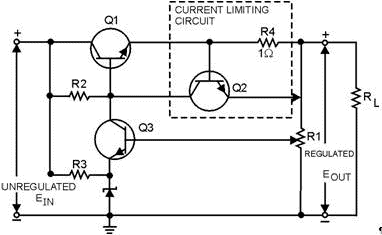
Figure 4-50. - Series regulator with current limiting. When load current is below 600 milliamperes, the base-to-emitter voltage on Q2 is not high enough to
allow Q2 to conduct. With Q2 cut off, the circuit acts like a series regulator. When the load current
increases above 600 milliamperes, the voltage drop across R4 increases to more than 0.6 volt. This causes Q2 to
conduct through resistor R2, thereby decreasing the voltage on the base of pass transistor Q1. This action causes
Q1 to conduct less. Therefore, the current cannot increase above 600 to 700 milliamperes. By increasing
the value of R4, you can limit the current to almost any value. For example, a 100- ohm resistor develops a
voltage drop of 0.6 volt at 6 milliamperes of current. You may encounter current-limiting circuits that are more
sophisticated, but the theory of operation is always the same. If you understand this circuit, you should have no
problem with the others.
TROUBLESHOOTING Power SUPPLIES
Whenever you are working with electricity, the proper use of safety precautions is of the utmost importance to
remember. In the front of all electronic technical manuals, you will always find a section on safety precautions.
Also posted on each piece of equipment should be a sign listing the specific precautions for that equipment. One
area that is sometimes overlooked, and is a hazard especially on board ship, is the method in which equipment is
grounded. By grounding the return side of the power transformer to the metal chassis, the load being supplied by
the power supply can be wired directly to the metal chassis. Thereby the necessity of wiring directly to the
return side of the transformer is eliminated. This method saves wire and reduces the cost of building the
equipment, and while it solves one of the problems of the manufacturer, it creates a problem for you, the
technician. Unless the chassis is physically grounded to the ship's ground (the hull), the chassis can be charged
(or can float) several hundred volts above ship's ground. If you come in contact with the metal chassis at the
same time you are in contact with the ship's hull, the current from the chassis can use your body as a low
resistance path back to the ship's ac generators. At best this can be an unpleasant experience; at worst it can be
fatal. For this reason Navy electronic equipment is always grounded to the ship's hull, and approved rubber mats
are required
4-52
in all spaces where electronic equipment is present. Therefore, before starting to work on any
electronic or electrical equipment, ALWAYS ENSURE THAT The Equipment and ANY Test Equipment YOU ARE USING Is
PROPERLY Grounded and THAT The RUBBER MAT YOU ARE Standing ON Is IN GOOD CONDITION. As long as you follow these
simple rules, you should be able to avoid the possibility of becoming an electrical conductor.
TESTING
There are two widely used checks in testing electronic equipment, VIsUAL and Signal TRACING. The importance of the
visual check should not be underestimated because many technicians find defects right away simply by looking for
them. a visual check does not take long. In fact, you should be able to see the problem readily if it is the type
of problem that can be seen. You should learn the following procedure. You could find yourself using it quite
often. This procedure is not only for power supplies but also for any type of electronic equipment you may be
troubleshooting. (Because diode and transistor testing was covered in chapter 1 and 2 of this module, it will not
be discussed at this time. If you have problems in this area, refer to chapter 1 for diodes or chapter 2 for
transistors.) 1. BEforE YOU ENERGIZE The Equipment, LOOK for: a. ShortS - Any terminal or
connection that is close to the chassis or to any other terminal should be examined for the possibility of a
short. a short in any part of the power supply can cause considerable damage. Look for and remove any stray drops
of solder, bits of wire, nuts, or screws. It sometimes helps to shake the chassis and listen for any tell-tale
rattles. Remember to correct any problem that may cause a short circuit; if it is not causing trouble now, it may
cause problems in the future.
b. DIsCOLORED OR LEAKING Transformer - This is a sure sign that there is a short somewhere. Locate it. If the
equipment has a fuse, find out why the fuse did not blow; too large a size may have been installed, or there may
be a short across the fuse holder. c. LOOSE, BROKEN, OR CORRODED CONNECTION - Any connection that is not
in good condition is a trouble spot. If it is not causing trouble now, it will probably cause problems in the
future. Fix it. d. DAMAGED ResistorS OR Capacitors - a resistor that is discolored or charred has been
subjected to an overload. An electrolytic capacitor will show a whitish deposit at the seal around the terminals.
Check for a short whenever you notice a damaged resistor or a damaged capacitor. If there is no short, the trouble
may be that the power supply has been overloaded in some way. Make a note to replace the part after signal
tracing. There is no sense in risking a new part until the trouble has been located.
2. ENERGIZE The Equipment and LOOK for: a. SMOKING PARTS - If any part smokes or if you hear any
boiling or sputtering sounds, remove the power immediately. There is a short circuit somewhere that you have
missed in your first inspection. use any ohmmeter to check the part once again. Start in the neighborhood of the
smoking part. b. SPARKING - Tap or shake the chassis. If you see or hear sparking, you have located a
loose connection or a short. Check and repair. If you locate and repair any of the defects listed under
the visual check, make a note of what you find and what you do to correct it. It is quite probable you have found
the trouble. However, a good technician
4-53
takes nothing for granted. You must prove to yourself that the equipment is operating properly and
that no other troubles exist. If you find none of the defects listed under the visual check, go ahead with
the signal tracing procedure. The trouble is probably of such a nature that it cannot be seen directly-it may only
be seen using an oscilloscope. Tracing the ac signal through the equipment is the most rapid and accurate
method of locating a trouble that cannot be found by a visual check, and it also serves as check on any repairs
you may have made. The idea is to trace the ac voltage from the transformer, to see it change to pulsating dc at
the rectifier output, and then see the pulsations smoothed out by the filter. The point where the signal stops or
becomes distorted is the place look for the trouble. If you have no dc output voltage, you should look for an open
or a short in your signal tracing. If you have a low dc voltage, you should look for a defective part and keep
your eyes open for the place where the signal becomes distorted. Signal tracing is one method used to
localize trouble in a circuit. This is done by observing the waveform at the input and output of each part of a
circuit. Let's review what each part of a good power supply does to a signal, as shown in figure 4-51. The
ac voltage is brought in from the power line by means of the line cord. This voltage is connected to the primary
of the transformer through the ON-ofF switch (S1). At the secondary winding of the transformer (points 1 and 2),
the scope shows you a picture of the stepped-up voltage developed across each half of the secondary winding-the
picture is that of a complete sine wave. Each of the two stepped-up voltages is connected between ground and one
of the two anodes of the rectifier diodes. At the two rectifier anodes (points 4 and 5), there is still no change
in the shape of the stepped-up voltage-the scope picture still shows a complete sine wave.

Figure 4-51. - Complete power supply (without regulator). However, when you look at the scope pattern for point 6 (the voltage at the rectifier cathodes), you see
the waveshape for pulsating direct current. This pulsating dc is fed through the first choke (L1) and filter
capacitor (C1) which remove a large part of the ripple, or "hum," as shown by the waveform for point 7. Finally
the dc voltage is fed through the second choke (L2) and filter capacitor (C2), which
4-54
remove nearly all of the remaining ripple. (See the waveform for point 8, which shows almost no
visible ripple.) You now have almost pure dc. No matter what power supplies you use in the future, they
all do the same thing - they change ac voltage into dc voltage. Component Problems
The following paragraphs will give you an indication of troubles that occur with many different electronic circuit
components. Transformer and CHOKE TROUBLES. - As you should know by now, the transformer
and the choke are quite similar in construction. Likewise, the basic troubles that they may develop are
comparable.
1. a winding can open. 2. Two or more turns of one winding can short together.
3. a winding can short to the casing, which is usually grounded. 4. Two windings (primary and secondary)
can short together. This trouble is possible, of course, only in transformers.
 When you have decided which of these four possible troubles could be causing the symptoms, you have
definite steps to take. If you surmise that there is an open winding, or windings shorted together or to ground,
an ohmmeter continuity check will locate the trouble. If the turns of a winding are shorted together, you may not
be able to detect a difference in winding resistance. Therefore, you need to connect a good transformer in the
place of the old one and see if the symptoms are eliminated. Keep in mind that transformers are difficult to
replace. Make absolutely sure that the trouble is not elsewhere in the circuit before you change the transformer.
Occasionally, the shorts will only appear when the operating voltages are applied to the transformer. In this
case you might find the trouble with a megger-an instrument which applies a high voltage as it reads resistance.
Capacitor and Resistor TROUBLES. - Just two things can happen to a capacitor: 1. It may open up,
removing the capacitor completely from the circuit. 2. It may develop an internal short circuit. This
means that it begins to pass current as though it were a resistor or a direct short.
4-55

You may check a capacitor suspected of being open by disconnecting it from the circuit and checking it
with a capacitor analyzer. You can check a capacitor suspected of being leaky with an ohmmeter; if it reads less
than 500 kilohms, it is more than likely bad. However, capacitor troubles are difficult to find since they may
appear intermittently or only under operating voltages. Therefore, the best check for a faulty capacitor is to
replace it with one known to be good. If this restores proper operation, the fault was in the capacitor.
Resistor troubles are the simplest. However, like the others, they must be considered. 1. a resistor
can open. 2. a resistor can increase in value. 3. a resistor can decrease in value.
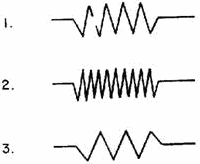
You already know how to check possible resistor troubles. Just use an ohmmeter after making sure no
parallel circuit is connected across the resistor you wish to measure. When you know a parallel circuit is
connected across the resistor or when you are in doubt disconnect one end of the resistor before measuring it. The
ohmmeter check will usually be adequate. However, never forget that occasionally intermittent troubles may develop
in resistors as well as in any other electronic parts. Although you may observe problems that have not
been covered specifically in this chapter, you should have gained enough knowledge to localize and repair any
problem that may occur. Q41. What is the most important thing to remember when troubleshooting?
Q42. What is the main reason for grounding the return side of the transformer to the chassis? Q43.
What are two types of checks used in troubleshooting power supplies?
4-56
Summary This chapter has presented you with a basic description of the theory and operation of a basic power supply
and its components. The following summary is provided to enhance your understanding of power supplies.
Power SUPPLIES are electronic circuits designed to convert ac to dc at any desired level. Almost
all power supplies are composed of four sections: transformer, rectifier, filter, and regulator.

The Power Transformer is the input transformer for the power supply.

The RECTIFIER is the section of the power supply that contains the secondary windings
of the power transformer and the rectifier circuit. The rectifier uses the ability of a diode to conduct during
one half cycle of ac to convert ac to dc. Half-WAVE RECTIFIERS give an output on only one
half cycle of the input ac. For this reason, the pulses of dc are separated by a period of one half cycle of zero
potential voltage.

FULL-WAVE RECTIFIERS conduct on both halves of the input ac cycles. As a result, the dc
pulses are not separated from each other. a characteristic of full-wave rectifiers is the use of a
4-57
center-tapped, high-voltage secondary. Because of the center tap, the output of the rectifier is
limited to one-half of the input voltage of the high-voltage secondary.
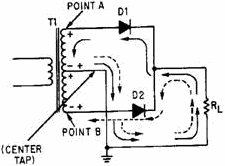
BRIDGE RECTIFIERS are full-wave rectifiers that do not use a center-tapped,
high-voltage secondary. Because of this, their dc output voltage is equal to the input voltage from the
high-voltage secondary of the power transformer. Bridge rectifiers use four diodes connected in a bridge network.
Diodes conduct in diagonal pairs to give a full-wave pulsating dc output.

FILTER Circuits are designed to smooth, or filter, the ripple voltage present on the
pulsating dc output of the rectifier. This is done by an electrical device that has the ability to store energy
and to release the stored energy. Capacitance FILTERS are nothing more than large
capacitors placed across the output of the rectifier section. Because of the large size of the capacitors, fast
charge paths, and slow discharge paths, the capacitor will charge to average value, which will keep the pulsating
dc output from reaching zero volts.
4-58
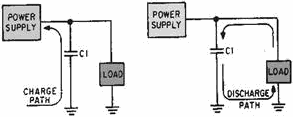
INDUCTOR FILTERS use an inductor called a choke to filter the pulsating dc input.
Because of the impedance offered to circuit current, the output of the filter is at a lower amplitude than the
input.
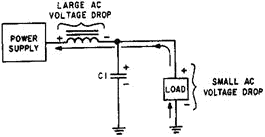
PI-TYPE FILTERS use both capacitive and inductive filters connected in a pi-type
configuration. By combining filtering devices, the ability of the pi filter to remove ripple voltage is superior
to that of either the capacitance or inductance filter.

Voltage REGULATORS are circuits designed to maintain the output of power supplies at a
constant amplitude despite variations of the ac source voltage or changes of the resistance of the load.
4-59
This is done by creating a voltage divider of a resistive element in the regulator and the resistance
of the load. Regulation is achieved by varying the resistance of the resistive element in the regulator.
a Series REGULATOR uses a variable resistance in series with the load. Regulation is achieved by
varying this resistance either to increase or to decrease the voltage drop across the resistive element of the
regulator. Characteristically, the resistance of the variable resistance moves in the same direction as the load.
When the resistance of the load increases, the variable resistance of the regulator increases; when load
resistance decreases, the variable resistance of the regulator decreases.

Shunt REGULATORS use a variable resistance placed in parallel with the load. Regulation
is achieved by keeping the resistance of the load constant. Characteristically the resistance of the shunt moves
in the opposite direction of the resistance of the load.

The CURRENT LIMITER is a short-circuit protection device that automatically limits the
current to a safe value. This is done when the current-limiting transistor senses an increase in load current. At
this time the current-limiting transistor decreases the voltage on the base of the pass transistor in the
regulator, causing a decrease in its conduction. Therefore, current cannot rise above a safe value.
TROUBLESHOOTING
is a method of detecting and repairing problems in electronic equipment. Two methods commonly used are the
VIsUAL CHECK and Signal TRACING. The visual check allows the technician to make a quick
check of component problems, such as shorts, discolored or leaky transformers, loose or broken connections,
damaged resistors or capacitors, smoking parts, or sparking. The signal tracing method is used when the technician
cannot readily see the problem and needs to use test equipment. Component failure is also important in
troubleshooting. In transformers and chokes, a winding can open, or two or more windings can short, either to
themselves or to the case that is usually grounded. In a capacitor only two things can occur: either it can short
and act as a resistor, or it can open, removing it from the circuit. a resistor can open, increase in value, or
decrease in value.
4-60
Answers to Questions Q1. Through Q43. A1. Transformer, rectifier, filter, regulator. A2. To change ac to pulsating dc.
A3. To change pulsating dc to pure dc. A4. To maintain a constant voltage to the load. A5.
The half-wave rectifier. A6. 15.9 volts. A7. It isolates the chassis from the power line.
A8. The fact that the full-wave rectifier uses the full output, both half cycles, of the transformer. A9. 120 hertz. A10. 63.7 volts. A11. Peak voltage is half that of the half-wave rectifier.
A12. The bridge rectifier can produce twice the voltage with the same size transformer. A13. It
will decrease. Capacitance is inversely proportional to:
 A14. The capacitor filter. A15. Parallel. A16. At a high
frequency.
A17. a filter circuit increases the average output voltage. A18. Value of
capacitance and load resistance. A19. Good. A20. Yes. A21.
The CEMF of the inductor. A22. From 1 to 20 henries. A23. Decrease.
A24. Expense. A25. When ripple must be held at an absolute minimum.
A26. LC capacitor-input filter. 4-61
A27. Cost and size of the inductor. A28. Regulators. A29. Variation.
A30. Series and shunt. A31. An increase.
A32. In parallel. A33. Bias. A34. Increases.
A35. Increases. A36. Decreases. A37. An increase.
A38. Two. A39. Trippler. A40. In parallel. A41. Safety precautions. A42.
To eliminate shock hazard. A43. Visual and signal tracing.
4-62
| - |
Matter, Energy,
and Direct Current |
| - |
Alternating Current and Transformers |
| - |
Circuit Protection, Control, and Measurement |
| - |
Electrical Conductors, Wiring Techniques,
and Schematic Reading |
| - |
Generators and Motors |
| - |
Electronic Emission, Tubes, and Power Supplies |
| - |
Solid-State Devices and Power Supplies |
| - |
Amplifiers |
| - |
Wave-Generation and Wave-Shaping Circuits |
| - |
Wave Propagation, Transmission Lines, and
Antennas |
| - |
Microwave Principles |
| - |
Modulation Principles |
| - |
Introduction to Number Systems and Logic Circuits |
| - |
- Introduction to Microelectronics |
| - |
Principles of Synchros, Servos, and Gyros |
| - |
Introduction to Test Equipment |
| - |
Radio-Frequency Communications Principles |
| - |
Radar Principles |
| - |
The Technician's Handbook, Master Glossary |
| - |
Test Methods and Practices |
| - |
Introduction to Digital Computers |
| - |
Magnetic Recording |
| - |
Introduction to Fiber Optics |
| Note: Navy Electricity and Electronics Training
Series (NEETS) content is U.S. Navy property in the public domain. |
|
























